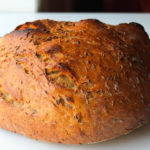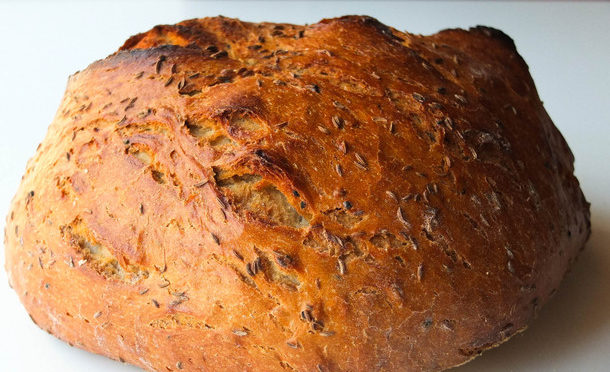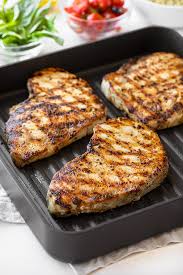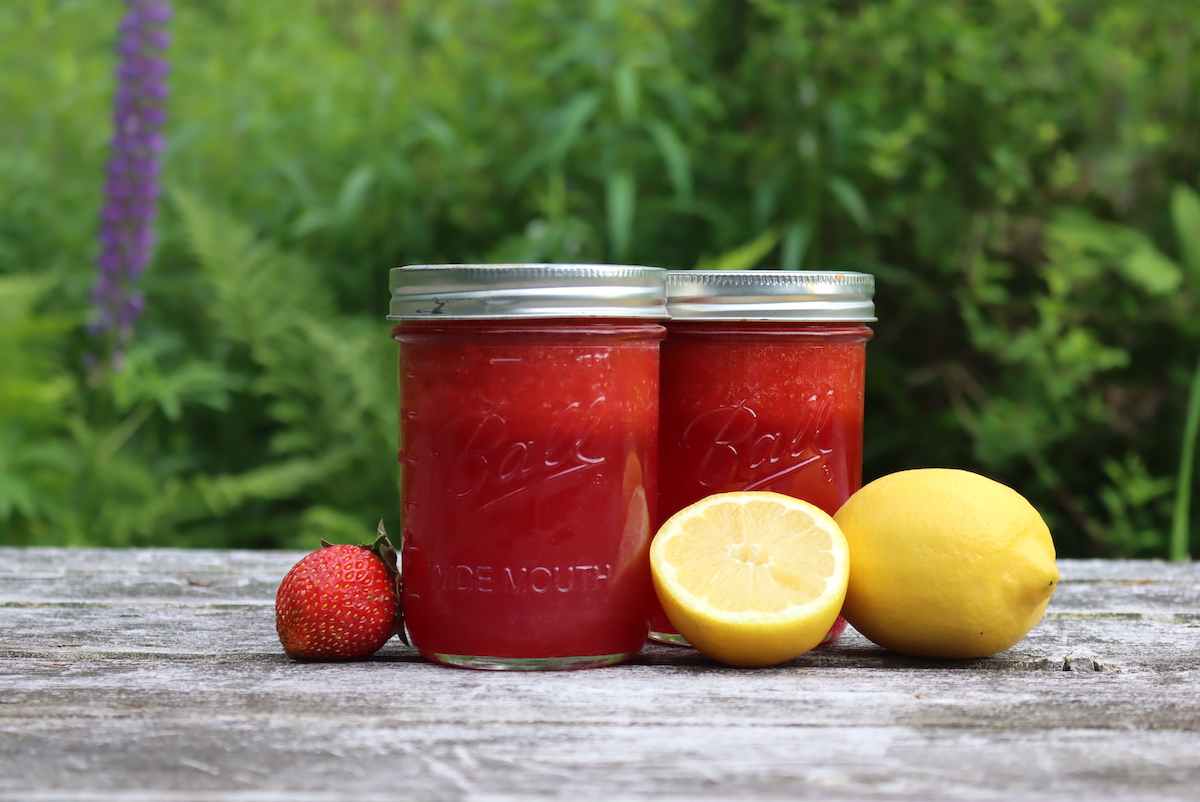I have been wanting to try making some breads and the desire to get some of the old Jewish recipes back struck.
This take some time. You need 48 hours to get the starter going.
Then you have the typical dough, kneed, rise, kneed cycle so its a long time to put everything together.

Jewish Corn Rye Bread
The Best Traditional Corn Rye Recipe on the Internet, built from scratch after research and talking to old NY bakers.
Ingredients
Rye Starter - Makes 4 cups of starter
- 1 Tbsp Dry Yeast
- 2 cups water warm
- 2 cups Rye Flour
- 1 Onion
- 1 cup water warm
- 1.5 cup Rye Flour
Corn Rye Bread
- 1.5 cup water warm
- 1 Tbsp dry yeast
- 1/2 tsp sugar
- 4 tsp kosher salt
- 3 cup Rye Sourdough Starter
- 2 cup High Gluten Flour
- 3.5 cup All-Purpose Flour
- cornmeal for dusting
- 1 egg for glaze
- 2 T water for glaze
- 2 tsp caraway seeds
Instructions
Rye Starter
-
48 hours before beginning rye bread, make this starter: Mix 1 T. dry yeast in 2 cups of tepid water.
-
Beat in 2 cups of rye flour. Add a small onion, peeled and halved. Cover the bowl with plastic wrap. Let stand at room temperature for 24 hours.
-
Remove onion. Beat in 1 cup tepid water and 1.5 cups rye flour. Cover and let stand for 24 hours longer.
-
This can be used immediately or refrigerated for 24 hours. This preparation makes about 4 cups of starter (a bit more than required for the bread).
Bread - The following directions are for hand kneading. If you have a heavy duty food processor, put all dough ingredients in work bowl after you have made the yeast starter. Add starter and combine. Dough will be fairly sticky. Don't use a food processor unless it is quite durable; this is a very heavy dough.
-
Combine 1/2 cup warm water, yeast, sugar, and let stand until double (10 min.).
-
Dissolve salt in remaining water. Mix in sourdough starter, then yeast mix.
-
Add gluten flour and 2 cups of all-purpose flour and optional caraway seeds; make a soft dough.
-
Spread 1.5 cups flour on kneading surface and turn dough out on it. Knead, adding more flour, to make a soft dough. Do not over-knead. The dough should be only slightly elastic, even a bit sticky. Form dough into a ball, and put in an un-greased bowl. Cover with plastic, and let rise until double (1.5 hours).
-
Knead, cover with towel, and let rest for 15 minutes. Divide into 2 parts. Form each into 12 inch loaf. Pinch seam, and place seam down on cornmeal-dusted sheet. Cover and let rise until 3/4 proof.
-
Put a large pan with 2 inches water in oven. Preheat to 400 °. Place quarry tiles on upper shelf of oven. Brush loaves with egg-white glaze, slash with knife. Sprinkle seeds on top. Bake for 30 minutes on tiles. Brush again with glaze; bake an additional 20 to 30 minutes.
Recipe Notes
This recipe takes time.




Doesn’t the dough have corn meal in it? Where’s the corn? Just on the outside dusting?
I remember that when I ate a Jewish corn rye bread, it absolutely tasted different from regular Jewish rye.
This does taste very different than a standard rye. The Corn part is actually the texture of the bread itself. Its a much heavier, thicker (sourdough like) desnsity.
i have a question: do we use the entire starter for this recipe? the notes say it makes more than needed, but the instructions don’t specify how much starter to add. want to make this for my bronx-born dad, thanks!
No – You use 3 cups as specified in the recipe. The starter process will generate a bit more based on location, humidity and altitude, but you need 3 cups per the recipe.
thx i saw that after i asked. how long can the extra starter live in the fridge? i’m thinking of trying to make a half batch & combine it w/the extra. do you think that would work? thx v much!
I haven’t ever really kept it, but I would imagine that it could last several days in the fridge (I have multiple starters there). The issue is that you will need take it our bring it to room temp and feed it again (rye flour).
Great recipe but wrong answer to how it got its name. I submit a short article by Ruth Reichel for a perfect answer and good back round for “corn bread.”
Rye Bread
Ruth Reichl
My father arrived in America in 1926. He was 26 years old, and he carried three things with him: a doctorate in German literature, a burning desire to work in publishing, and an utter contempt for American food.
He never changed. Dad looked at the cereal Mom and I occasionally breakfasted upon with loathing. He considered salad strange. The only vegetable that ever crossed his plate was red cabbage (preferably with sauerbraten). And although he was a gentle man, he refused to partake of any meal that lacked a basket of bread.
“Not those fluffy white slices that evaporate in your mouth,” Dad said contemptuously. He wanted sturdy stuff you could sink your teeth into, a loaf with heft, color, and character. To please him, Mom went to the bakery every morning for a fresh loaf of seeded corn rye.
There is no corn in corn rye; Korn is the medieval German term for “grain,” but in bread it almost always refers to rye. The seeded corn ryes of my childhood were sourdough loaves, yeasty, light, and so rich with caraway seeds that their fragrance perfumed the entire table.
I hated that bread. It was embarrassing to show up at school with a lunchbox filled with thick sandwiches on mismatched slices that permeated the lunchroom with their telltale scent. I longed for the pristine square sandwiches other moms made, those clean, white envelopes with their innocent airs. I swore that when I grew up, I would never eat another slice of rye.
But as New York’s German population faded away and its Jews assimilated, their breads began to vanish. Corn rye became a thing of the past, and to my surprise, I missed it.
Happily, the artisan-bread movement has started bringing the old loaves back, and I find myself buying corn rye with increasing frequency, so eager for that familiar flavor that the loaf’s half gone before I reach home. It is, I realize, the taste of my childhood. And it occurs to me that, in this case, father really did know best.
Where can I buy this bread? I would have it shipped if necessary.
Lease email me: sallyluisi@comcast.net
I just sent you an email, but, Cohen’s bakery in Ellenville, NY will mail it to you. 8456477620
My understanding is that “lorn” refers to “grain”. The recipe does not include corn, as corn from a cob.
Your correct MARCIA D MILLER. Corn Rye is named so because of the ubiquitous heavy dusting of cornmeal on the bottom. This was to keep the very heavy sticky dough from sticking and acted like ball bearings to roll the bread in and out of the ovens. The onion in the starter changes the flavor though my experiences with Corn Rye were more textural. Heavy, Dense and moist with a distinct chew and thick crust. Onion may be a very traditional addition and may even help the starter. Onion is used in other Jewish Rye Starter Recipes Ive used. Jewish Deli Rye is one example and Ive seen it in some Pumpernickle recipes also. The loaves I bought at a very very traditional Bakery from a Jewish Neighborhood in my City. The loaves should be round, not egg washed at all. Coarse crusted with cross hatching cut into the top. The rise should be high even with the weight of the loaf taken into consideration. Dull , without shine. The loaves will feel very heavy and should cool and rest well after baking.
AndIll correct myself here, The more probalble reason for the name is that KORN is German for grain.
I believe the word corn was what the people of northeastern Europe (Poland, Lithuania,etc) called the rye kernels. I could be wrong about that but I have enjoyed corn rye bread for 65 years having grown up in north NJ.
Corn in the old language just meant grain .
Are used to buy a corn rye from Foodtown bakery every year for the holidays. My kids went crazy for it, but I know it had a flavor of corn in it too and it was a little yellow. It did not look like the regular round rye. Nor did it taste like it.
The corn refers to the grain. American rye bread is sometimes referred to as corn rye, possibly from the Yiddish korn (‘grain’), or from the use of cornmeal as a coating and handling aid.
The CORN is the Americanization of the German KORN.
This recipe (bakers call formula) seems close to what one would find back in the day at a “Jewish” bakery such as Alters in North Tarrytown, N.Y.
Many people prefer charnishkes to caraway seeds.
I’ve been a baker for over 40 yrs. Born in Germany. And yours is the correct answer. The German Jews would refer to this bread by the german word Korn, which has nothing to do with the american corn meal. It’s simply a form of rye bread. In my opinion one of the best artisan breads breads one can eat.
Do you still bake it? I’m happy to pay for shipping if you make multiple loaves! I’m in Atlanta and have checked with varios bakeries.
Diamond Bakery bakes a Corn rye and other Jewish bked goods and ships.
https://diamondbakeryla.com/
Diamond bakery makes the best corn rye in the world! I found your recipe thinking of that recipe. Have you had their corn rye? Is your recipe similar?
The recipe from Diamond Bakery has changed.
No longer a heavy chewy loaf.
As you are a baker, don’t you find that the slight kneading to this dough is slightly of the mark? All the pictures associated with this recipe (which appears several times on the web) show a poorly shaped very flat loaf or a mound of unshaped dough baked in a pot to hold it up. Nor are most of the loaves scored.
The hydration of the final dough comes in at about 71% which would be an easily shaped elastic white flour dough, but which, for a rye dough of a large amount of preferment, would be quite sticky and lacking in structure without strong kneading even with the added high gluten flour.
I prepared this several times tinkering with it. The loaf lost none of it’s flavor and gained much in structure by reducing the water in the final dough about 1/2 cup (70ml) and strong stretch and folds before the bulk proof as well as firm tight shaping before the final proof in a banneton. I refrigerated it for 3 hours after the second rise at when it had grown about 50% in volume rather than the 75% in the recipe. It proved to be easily scorable and had some good oven spring then.
Hi Stanley, I would like to ask what are charnishkes?? Thanks
I have been searching for “real” corn rye bread for years. My husband and I made this bread and baked it today. The search is over! The bread was dense, moist crusty, flavorful from the caraway seeds, and absolutely the best. Instructions were perfect.we baked it in a huge oval cast enamel Dutch oven and made one huge bread.thank you, Mike.
Thank you. I am glad you found this recipe helpful.
I was so skeptical of this recipe- having grown up with real Jewish Corn Rye in the Bronx, I doubted this would come close. To my amazement it exceeded all expectations- it is a fabulous recipe and now my husband who loves a good corn rye thinks I ought to go in to business making it!! One change- the real bakeries use a cornstarch and water solution to brush on the dough before baking to get a shiny crisp crust. 2 Tb. cornstarch dissolved in 1/4 cup cold water added to 1 cup boiling water, cook about 1 minute or less. Brush entire top with mixture just before making slashes and then again half way through the baking process. Also – soak kitchen towels and place on a sheet pan on bottom rack to get the best steam effect. Also- I raised the temperature half way through baking to 450 degrees.
Thanks for the comments. It really is one of my favorite recipes. I haven’t tried cornstarch and water, but will. Lets keep the tradition alive….
What does 3/4 proof mean?
My mother worked at Montefiore and brought us Jewish corn bread from Jerome Ave. I’ve searched for years for the name of the bakery — long gone. Do you know? It’swonderful to be able to reproduce that wonderful bread! Stay well.
I am sorry, I do not…
What does it mean 3/4 proof mean? I am on that step for the 1st time baking this.
This is probably the best description I can give…(from http://www.thefreshloaf.com/node/26938/how-tell-when-final-proof-done-ready-oven)
When you indent the dough about 1/2 inch with your finger you are feeling the quality of thenetting (gluten strands) that are holding the balloons of gas. The gluten has to be strong enough to hold the bubbles but relaxed enough to expand. It takes practice and familiarity with your dough. Not all doughs proof the same-either timewise or how they feel so keep poking the loaves.
For the most part the following is true:
If you indent and it stays indented-the loaf is overproofed. It will deflate if you slash it, in the oven or even when cooling,depending on how over proofed it is. The gluten strands that are trapping the gas bubbles is so overstretched and weakened, it can’t hold on anymore.When you press on them you actually break the strands holding the gas bubble. Think about holding a 25 lb weight out at arms length-pretty soon your muscles are shaking and “poof” they give out-esp if another ounce is added. If your yeast has enough oomph left, you may want to count this as an extra rise,re-shape and re-proof.
If you indent and it bounces back and fills in right away, the gluten strands are srtong and not very stretched-like a very tight ballon. You are just bouncing back. This is underproofed and you will end up with a dense crumb and possibly a brick. The gluten strands are so tight,yet, that the bubbles can’t expand against them so no oven spring for you. Keep going no matter what the clock says or how long it has been taking. A little warmth may speed things up but change can come very quickly! Watch that dough!
If you indent and it fills in slowly, some of the gluten bands are giving way but most are holding and the gas re-expands. This is perfectly proofed. The gluten bands are strong enough to hold the gas but still allow some expansion.Should have oven spring and the best crumb for that dough.
If you are working with a dough that proofs quickly or the gluten is particularly delicate (some flours do this), then you may want to 3/4 proof the loaf and allow the oven spring to complete the expansion. This is harder to describe-kind of “it indents but fills in quicker than a fully proofed loaf”.
I had the same question! A Google search took me to the exact same explanation. Very helpful.
Possibly garden bakery I think on burnside ave.
Used to eat this at Pride Bakery in Bayonne NJ.
Haven’t found it again. Any chance you could send it out of town?
Loved the bread. I took the left over rye starter and added it no knead dough. When it was done with the first rise I added dill and caraway seeds. After the second rise I baked it in an Emil Henri potato and bread pot.
I bit off more than I can chew. This is my first attempt at making bread and I don’t think I did it right. I followed all the instructions and just finished #4 of the bread making portion of the recipe. My dough doesn’t form a ball, it’s too soft and sticky. It’s rising right now, but I’m not sure if there’s something I should do to try to fix it now. Don’t know how frequently you read this, but if you have any suggestions I will be watching. thanks.
You could always add a little more flour if it doesn’t have enough structure.
Maybe you did what i did—put in ALL the starter! Didnt realize this til long after i baked it. Mike could help prevent this by changing the directions to say “ mix in the 3 cups of starter” instead of “mix in the starter.”
please tell me what the onion does. does it add flavor or does it have something to do with the starter making it sower
I believe it gives you a different flavor for your starter. You won’t get the full effect without it.
Baked it last nigh. Followed instructions to a T. (Was a bit unsure at the kneading stage how much flour to add, how sticky it should be, but trusted my judgment and instruction not to over-knead). Got to loaves as close to perfection as I could imagine—matched or exceeded the wonderful childhood memories, and as good or better than any I have bought in one of NYC’s better bakeries! Thanks!!
Has anyone tried this in a bread machine? My hands get too sore to knead properly…
I haven’t used a bread machine, but I have used a Kitchen Aid with a Dough hook to the first step knead. You will need to do some by hand to get the right texture, but the initial steps can be done by machine.
What kind if kosher salt did you use?
Dangerous question (and not going to start a Koser Salt flame thread) but I use Morton’s.
Have you experimented baking in a Dutch Oven? Does the baking time hold true? I typically bake loaves in a dutch oven (30 minutes covered and 15-20 minutes uncovered) which generally provides the early steam and then a good crust. Any thoughts?
I have done some of my other breads in a dutch oven, but not this one, although I am sure it would work. This is probably something like 30 min covered and then 20-25 min uncovered, but you will have to experiment….This gets a REALLY nice rise in the oven so make sure you have enough room in the dutch oven and make sure it doesn’t get trapped by the lid….
I just baked this bread and nearly got any rise. Very disappointed
Sorry to hear that….I have made this multiple times. The starter should be nice and bubbly when you use it. If you didn’t get a rise, either your starter was bad (you didn’t get any yeast to develop) or the environment wasn’t proper. This puffs up very nicely when kept in a warm dry location.
I am new to bread making. What do I do with the 1 cup of leftover starter? If I keep it (1 cup of starter) in the fridge, how do I use it to make another recipe i.e. turn it into 3 cups of starter?
At this point, its left over starter. Its a little different than traditional starter as it was started from yeast, but can treat it like normal starter and feed it and grow it for other things. It will always be a onion backed rye starter.
Wish i could include the picture! Put one loaf in fridge (i live alone) and put the other on a pizza stone. Tastes delicious. I erred on the side of too sticky which left a lot of messes, and didn’t use a big enough bowl for the first rise, but tastes like rye bread and is 4” tall. Could have been taller ill bet, but not bad for first time!
When I lived in Pittsburgh there were several bakeries in ‘Squirrel Hill’ a predominately Jewish neighborhood. Today they are gone, or the current generation of bakers don’t make it anymore. The only place I can find it is ‘The Pittsburgh BreadWorks’ and they only make it on Saturdays. Because I now live a distance away, I will buy 3-4 loves and freeze it. They won’t cut the bread for you because it breaks their bakery knives. Yum!
would love to try this recipe. I don’t have quarry tiles. How necessary to the end result are the tiles? Where is a good source to purchase quarry tiles for oven use?
Thanks,
Suzanne
Any pizza stone type thing will work. The goal is to put it into a hot oven and onto a hot tile so you can get a crispier bottom. I’ve used a hot metal pan as well but it tends to be uneven.
Wow
I will be trying this but I wanted to thank you so much for getting straight to the recipe without all of the blah blah blah.
I have two questions about flour. First, what kind of rye flour should I use? My supermarket only sells dark rye. Online I have also seen white and medium. Second, can I substitute bread flour for high gluten flour?
For the type of rye flour, it depends on how prominent you want rye in the bread. I prefer the medium variety, and would stay away from the whole-germ (pumpernickel). But I know folks who have been successful with light.
Bread flour is the most readily available high gluten flour in the market, but others will work. I am partial to the King Arthur’s Bread Flour and their Medium Rye for this recipe.
I have wonderful memories of eating corn bread when visiting my grandparents in New York in the 1970’s & 1980’s – it left long-standing memories with me and my brother who still reminisce over corn bread. Neither of us have been able to locate a bakery where corn bread is baked and sold. Any recommendations on where corn bread can be found? (Jewish corn rye, as you call it).
I have a lively sourdough starter already established. I’m going to try this recipe using my starter but feed it with rye and an onion and proceed with this recipe, and see how it goes.
Lets see how it goes. I think it will loose some of its depth, but you will have to report back?